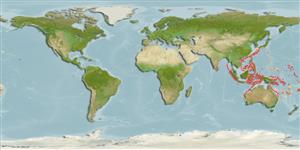>
Tetraodontiformes (Puffers and filefishes) >
Triacanthodidae (Spikefishes) > Triacanthodinae
Etymology: Halimochirurgus: Greek, alimos, -os, -on, marine, salted + Greek, cheirourgis, -ou = manual worker (Ref. 45335).
More on author: Alcock.
Environment: milieu / climate zone / depth range / distribution range
Ekologi
marina bottenlevande; djupintervall ? - 262 m (Ref. 58018). Tropical
Indo-West Pacific: Andaman Sea and Indo-Australian Archipelago.
Size / Vikt / Age
Maturity: Lm ? range ? - ? cm
Max length : 15.0 cm TL hane/ej könsbestämd; (Ref. 3132)
Inhabits trawling grounds (Ref. 3132).
Life cycle and mating behavior
Könsmognad | Reproduktion | Lek | Ägg | Fecundity | Larver
Allen, G.R. and R. Swainston, 1988. The marine fishes of north-western Australia: a field guide for anglers and divers. Western Australian Museum, Perth. 201 p. (Ref. 3132)
IUCN Red List Status (Ref. 130435: Version 2024-2)
Threat to humans
Harmless
Human uses
Verktyg
Special reports
Download XML
Internet-källor
Estimates based on models
Preferred temperature (Ref.
123201): 12 - 20.7, mean 15.1 °C (based on 45 cells).
Phylogenetic diversity index (Ref.
82804): PD
50 = 0.7500 [Uniqueness, from 0.5 = low to 2.0 = high].
Bayesian length-weight: a=0.01995 (0.00906 - 0.04395), b=3.01 (2.83 - 3.19), in cm total length, based on all LWR estimates for this body shape (Ref.
93245).
Trofisk nivå (Ref.
69278): 4.3 ±0.8 se; based on size and trophs of closest relatives
Fishing Vulnerability (Ref.
59153): Low vulnerability (10 of 100).
